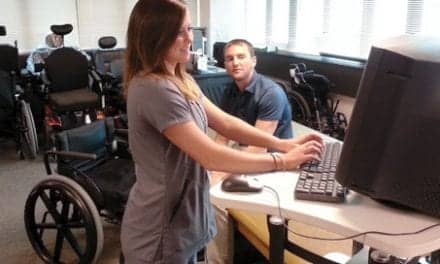 |
|
A new University of Utah study shows that arrays of tiny electrodes placed between the skull and the brain can accurately detect brain signals that command arm movements—raising hope for longer-lived devices to help amputees control bionic arms and for paralyzed people to operate computers with their thoughts. These two images show two kinds of microelectrode arrays, known and microECoGs, which were placed on the brains of severe epilepsy patients. The patients already had parts of their skulls removed temporarily for placement of larger ECoG electrodes, which are used to locate and treat the brain area responsible for their seizures. These larger, metallic, button-like electrodes are numbered in both images. The left image also shows two microECoG arrays, each with 16 microelectrodes connected to microwires that pass through the orange and green tubes. Because the arrays are made of fine wires embedded in clear silicone, photo-editing software was used to draw in their outlines in both images. The right image shows one microECoG array with 32 individual microelectrodes, connected with microwires entering via a clear tube from the bottom of the image. The green wires are connected to the large, conventional ECoG electrodes. |
Experimental devices that read brain signals have helped paralyzed people use computers and may let amputees control bionic limbs. Existing devices use tiny electrodes that poke into the brain, notes a University of Utah study, which shows that brain signals controlling arm movements can be detected accurately using new microelectrodes that sit on the brain but don’t penetrate it.
The new array of microelectrodes someday might be placed over the brain’s speech center in patients who cannot communicate because they are paralyzed by spinal injury, stroke, Lou Gehrig’s disease, or other disorders, says Bradley Greger, assistant professor of bioengineering and coauthor of the study. The electrodes would send speech signals to a computer that would covert the thoughts to audible words.
In as statement released by the university, Greger says the device should allow a high level of control over a prosthetic limb or computer interface for people who have lost a limb or are paralyzed. He adds that it would help amputees or people with severe paralysis to interact with their environment using a prosthetic arm or a computer interface that decodes signals from the brain.
The study is scheduled for online publication on July 1 in the journal Neurosurgical Focus.
The findings represent "a modest step" toward use of the new microelectrodes in systems that convert the thoughts of amputees and paralyzed people into signals that control lifelike prosthetic limbs, computers, or other devices to assist people with disabilities, says University of Utah neurosurgeon Paul A. House, the study’s lead author, in the statement.
Such technology already has been developed in experimental form using small arrays of penetrating electrodes that stick into the brain. The University of Utah pioneered development of the 100-electrode Utah Electrode Array used to read signals from the brain cells of paralyzed people, according to the statement. In experiments in Massachusetts, researchers used the small, brain-penetrating electrode array to help paralyzed people move a computer cursor, operate a robotic arm and communicate.
Meanwhile, researchers at the University of Utah and elsewhere are working on a $55 million Pentagon project to develop a lifelike bionic arm that war veterans and other amputees would control with their thoughts, just like a real arm, says the university. Scientists are debating whether the prosthetic devices should be controlled from nerve signals collected by electrodes in or on the brain, or by electrodes planted in the residual limb.
The new study was funded partly by the Defense Advanced Research Projects Agency’s bionic arm project, and by the National Science Foundation and Blackrock Microsystems, which provided the system to record brain waves.
Not only are the existing, penetrating electrode arrays undesirable for use over critical brain areas that control speech and memory, but the electrodes likely wear out faster if they are penetrating brain tissue rather than sitting atop it, Greger and House say in the statement. Nonpenetrating electrodes may allow a longer life for devices that will help disabled people use their own thoughts to control computers, robotic limbs or other machines.
The new kind of array is called a microECoG – because it involves tiny or "micro" versions of the much larger electrodes used for electrocorticography, or ECoG, developed a half century ago, says the university.
ECoG and microECoG represent an intermediate step between electrodes that poke into the brain and EEG (electroencephalography), in which electrodes are placed on the scalp, says the university. Because of distortion as brain signals pass through the skull and as patients move, EEG isn’t considered adequate for helping disabled people control devices.
The regular-size ECoG electrodes are too large to detect many of the discrete nerve impulses controlling the arms or other body movements, according to the university.
To read the entire story, click here.
[Source: The University of Utah]




